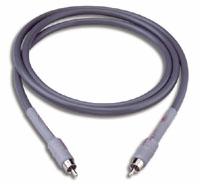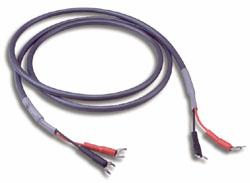![[SoundStage!]](../sslogo3.gif) Home Audio Home Audio Equipment Review |
|
June 1998 Cardas 300B-MicroTwin Interconnects and Twinlink A Speaker Cableby James Causey
Ever since I entered the strange, wonder-world of high-end audio, I’ve been hearing this constantly. From my girlfriend. From my parents. From my non-audiophile friends. And, to a degree, it’s quite understandable; at first, I didn’t believe that wire could sound different either. Most consumers don’t believe that wire makes any difference at all, an attitude reinforced by many certain head-in-the-sand objectivists (who shall remain nameless). As with many other "truths" in the audiophile world, a part of me wishes this were true so that I wouldn’t spend so much time in the nerve-wracking and wallet-draining process of finding the perfect wires. My attitude changed when I was in the process of shopping for my first high-end system. I asked my friendly local dealer if cables really made a difference. He sat me down in front of a demo system and told me to listen carefully to the CDs I had brought with me. He came back later and swapped the interconnects used in the system with some of the wire that came in the boxes with the gear. The difference, as anyone reading this probably already knows, was like night and day. The soundstage completely disappeared, to be replaced with a strange, "directly-from-the-speakers" kind of sound. The detail I’d learned to cherish disappeared into a muddy haze. Tori Amos’ voice, which had been cutting directly into my heart, merely hissed and grated. I perform the same demo now for my incredulous non-audiophile buddies, and they’re often just as floored as I was (though the effect is even more dramatic when I swap my Kimber 8TC speaker wire for entry-level 14-gauge stuff). Thus, it seemed appropriate that my first review for SoundStage! should be of wire, particularly when you consider the degree of incredulity I heaped upon manufacturers of expensive interconnects and speaker cables in my pre-audiophile days. In this case, I’ve been listening through some of Cardas Audio’s entry-level wires: the TwinLink A speaker cable, and 300B-MicroTwin interconnects, which are price-competitive with my current reference, the Kimber PBJ interconnect (with upgraded WBT RCAs) and 8TC speaker cable (with upgraded WBT bananas). Cardas and all that Cardas cables are designed using a philosophy that George Cardas describes as "Golden Ratio, Constant Q." Cardas states that the famous "Golden Ratio" or "Golden Mean" (1 to 1. 6180339887, and so on and so forth), used by the ancients as a benchmark in designing such monuments as the Great Pyramids at Giza and the Parthenon in Athens, also provides the ultimate reference in designing strand networks for audio cables. (The Golden Mean is also found in nature, in such artifacts as the nautilus shell which graces the Cardas logo and much of their artwork) This technique, patented by Cardas Audio, is intended to dissipate cable resonance, which Cardas sees as an enemy to pure signal transfer. Cable resonance/ringing saps the purity and clarity from the signal, and Cardas conductors are designed to further eliminate inner-conductor resonance by placing the smaller conductors toward the inside of the conductor networks, progressively increasing the size of the conductors toward the outside of the cable. All Cardas conductors are made of high-quality pure coated Litz copper. The unique nature of the wire makes it extremely difficult and expensive to terminate; thus, you must send your wire back to Cardas for any desired retermination—and not make it DIY project. This discussion made a lot of sense to me; however, I wanted to hear for myself just how superior this technique really is. When I opened the sealed baggies and removed the Cardas wires, I was immediately struck by the quality of manufacture and termination. The interconnects are covered with a very smooth, rubber-like coating, and have secure, tight RCA plugs installed by Cardas’s own "Silent Terminators." The speaker wire is covered with a semi-transparent plastic coating that simply begs to be fondled, and produced some interesting, almost static-electricity-like interactions when touched or rubbed against itself or other wires. The rhodium spade terminations on my review samples shared the clean quality of the RCAs on the interconnects. The wire doesn’t have the flashy, colorful beauty of my reference Kimber, but that almost enhances the sense of quality it exudes. System I used the Cardas interconnects and speaker cable in my reference system: McCormack DNA-1 power amplifier (standard version), McCormack TLC-1 passive linestage (buffered outputs used for review) and Parasound C/DP-1000 integrated CD player, all resting on a Michael Green Designs Justarack. All contacts were cleaned with Radio Shack contact cleaner and treated with XLO TPC (The Perfect Connection) wipes. I use no power conditioning, but I do plug all items into Belkin surge suppressers for added safety. For comparison, I had Kimber PBJ and Hero interconnects, and 8TC speaker wire. I finally pried myself away from obsessively ogling and fondling the Cardas wire long enough to hook it up. The MicroTwin interconnects went in without a hitch; the RCAs were extremely tight, but slid onto my McCormack amp and preamp with a minimum of fuss, producing a very tactile "ker-snik" sensation when they were on all the way. They provide a very clean, tight mechanical connection, but as long as care is used in their use, they didn’t fill me with fear for the integrity of my system’s connectors as some wire does. I had a harder time with the TwinLink speaker cable, but that’s not Cardas’s fault; my PSB 1000I speakers have the largest-diameter binding posts I’ve ever seen, making it damned near impossible to fit spades around them (my experience during this review has caused me to dub them "The Posts From Hell," and they’re the only negative feature of my otherwise-beloved PSBs). My past solution to this problem has been to carefully bend spades to fit around the massive girth of the posts; however, experimentation led me to beg off this technique, as the textured rhodium connectors which come standard on the Cardas wire are far too brittle to bend without damaging. Some advice from Doug Schneider led me to search for some spade-to-banana converters, but none of the local dealers seemed to carry them. My salvation came in the form of the large hole in the center of the PSB binding posts. I was able to slip one side of the spade through this hole, and tighten down the posts enough to get a decent connection (though one of the speakers needed significant re-engineering—e.g., brutal bending—of the bridging clip in order to clamp down tightly enough on the spades). I shook my head, hoping that the semi-lame quality of my connection wouldn’t cast the review in a negative light, and sat down to listen to this new wire. In use
I then proceeded to break in the wire with two and a half weeks of near-constant play, using sources as varied as FM static, bad top-40 CDs, and television programs. My late-night pleasure-listening sessions throughout this period noticed a definite hardening of focus, as everything seemed to settle in and be more crisp and clear. The bass cleared up quite a bit, while still having a pleasing sense of depth and power. The punchiness and snap I was used to with my other wire did return, though not to the degree I was used to, which presented me with a real dilemma: Did I prefer deep-but-fuzzy, or crisp-but-lightweight? I’m still not sure. This strange bass performance could very well have been due to my awkward connections; I’d be very curious to hear how the same wire performs with banana termination similar to that of my 8TC. After break-in, the Cardas wire also presents an excellent sense of forward-to-back imaging, due perhaps to its slightly forward bent. Tori Amos’ voice on "Caught A Light Sneeze" from Boys For Pele [Atlantic 82862-2] floated distinctly in front of the various instruments, and sliced deeper inside me than before, with more detail and breathy rasp, though without unpleasant grain. The sound of the strings on the guitar in Pink Floyd’s "Wish You Were Here," from the disc of the same name [Columbia Mastersound CK 64405], also shared this sense of detail, hanging in space and nearly taking my breath away. Since front-to-back imaging is another serious weakness in my system, this was a welcome improvement. All in all Cardas has created an excellent value in cabling, providing good imaging and detail in the highs and mids, and deep, rich (though slightly muddy) bass. My system uses McCormack’s passive TLC-1 linestage, which makes bass an iffy, difficult-to-discern issue; in the context of a more traditional active system, I think the difference in bass would be more distinct and noticeable, making the difference much more of a decision in personal taste. Even in the end, the sound of the Cardas wire was very similar to that of my current Kimber setup, and I had to work very hard to discern the differences. All the differences I did find were merely changes in character, providing a slightly more forward and dry sound with deeper lows than I was used to from my system. The Cardas wire deserves a serious audition. I think the minor differences I detected could be extremely important during the fine art of system matching, especially in a system with an active preamplifier. I’d happily recommend the Cardas cable to anyone interested in wire in this price range, especially if the sound it helped create found a happy home in the context of the buyer’s personal audio system. ...James Causey
|
|
|
|
![[SoundStage!]](../sslogo3.gif) All Contents All ContentsCopyright © 1998 SoundStage! All Rights Reserved |
 "You paid how
much? For wire?"
"You paid how
much? For wire?" Cardas suggests several days
of break-in before their wire performs its best, so I didn’t want to be too picky on
my first listen. However, from the time I pressed play on my system, I was instantly
impressed with the out-of-the-bag quality of this wire. It immediately threw a wide
soundstage, with excellent ambience and drive. Over time, it became clear that the bass, a
current weak point in my system, was deeper than with my reference wire; however, it was
also muddier, with less snap and punch. The Cardas wire had a more forward presentation as
well. However, the thing that I noticed more than anything else: the extreme similarity to
my current wire. It’s in my review notes from that evening, in big caps: NO HUGE,
OBVIOUS DIFFERENCES. I did notice a certain spittiness and lack of focus, which I thought
might be due to the wire’s newness.
Cardas suggests several days
of break-in before their wire performs its best, so I didn’t want to be too picky on
my first listen. However, from the time I pressed play on my system, I was instantly
impressed with the out-of-the-bag quality of this wire. It immediately threw a wide
soundstage, with excellent ambience and drive. Over time, it became clear that the bass, a
current weak point in my system, was deeper than with my reference wire; however, it was
also muddier, with less snap and punch. The Cardas wire had a more forward presentation as
well. However, the thing that I noticed more than anything else: the extreme similarity to
my current wire. It’s in my review notes from that evening, in big caps: NO HUGE,
OBVIOUS DIFFERENCES. I did notice a certain spittiness and lack of focus, which I thought
might be due to the wire’s newness.